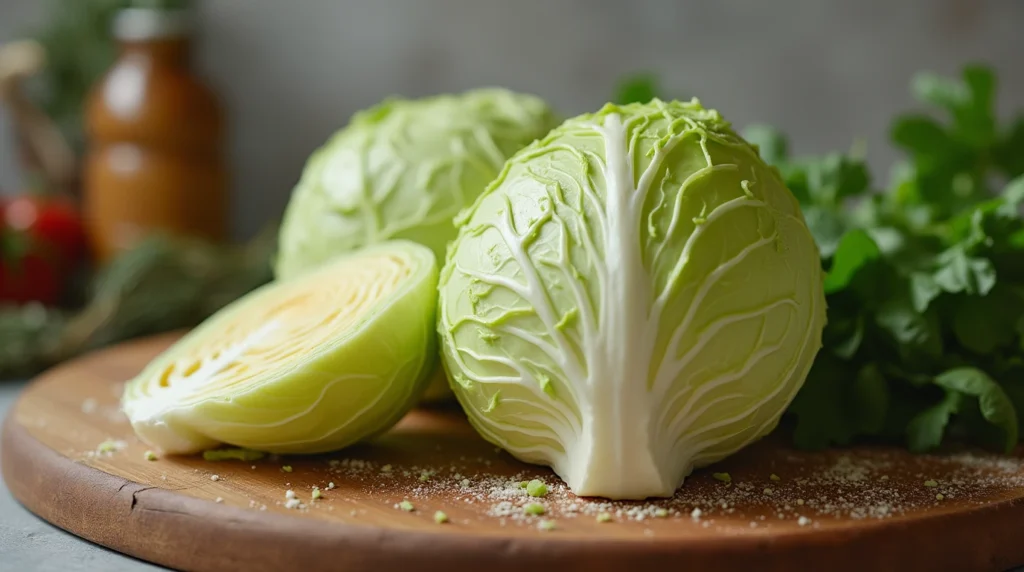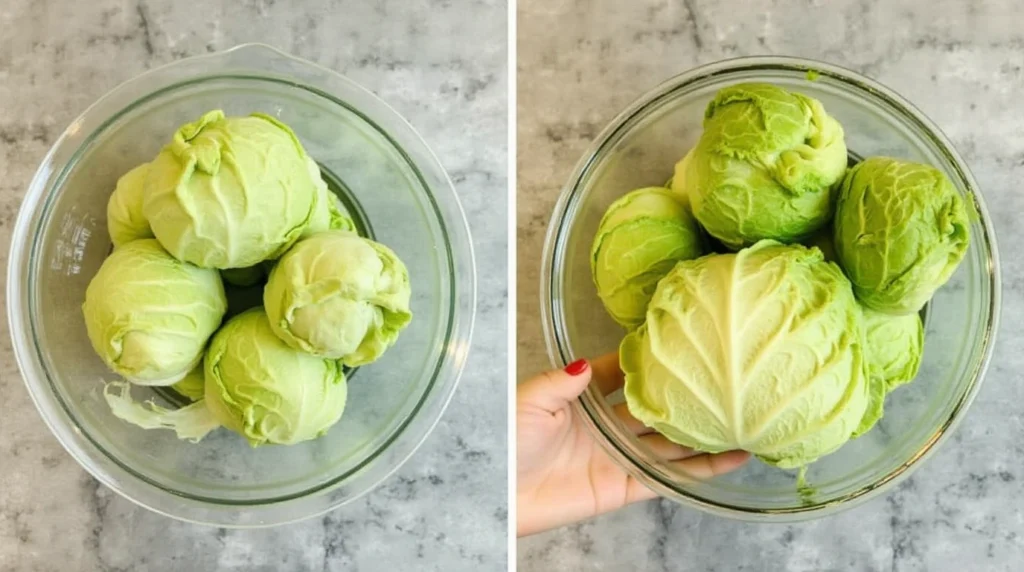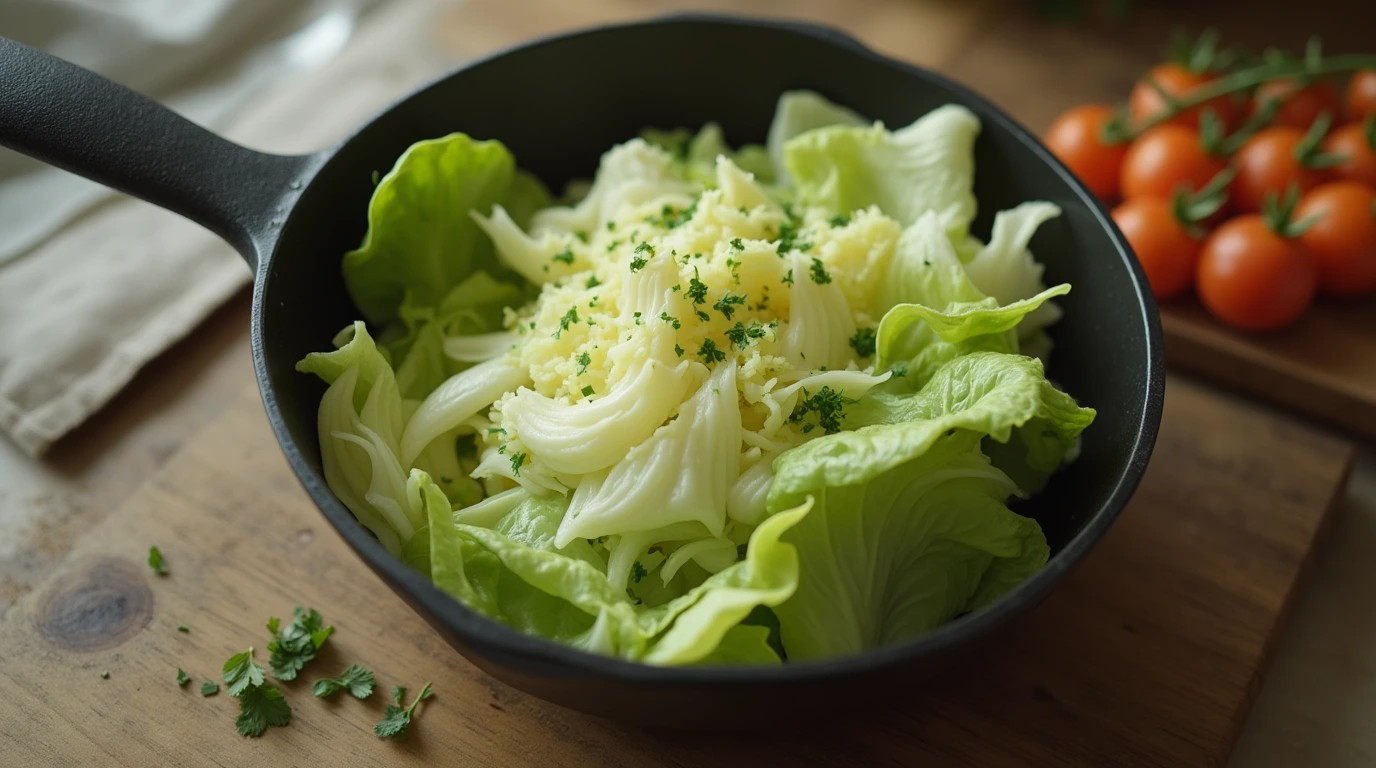Soaking cabbage is more than just a cooking trick. It brings out many benefits. By soaking cabbage, you can make it improve cabbage texture, taste better, and be cleaner. This is key for dishes like coleslaw and salads, where cabbage is raw.so why do you soak cabbage before cooking?
The compounds in cabbage, like glucosinolates, give it a bitter taste and a strong smell. Soaking gets rid of these, making it more enjoyable to eat.
Soaking also keeps the leaves crisp, perfect for coleslaw. It’s a simple step that boosts the benefits of soaking cabbage. It removes dirt, pesticides, and bugs from the leaves. You can soak it in water, saltwater, or vinegar, preparing it for tasty dishes like a cabbage and egg recipe.

The Historical Significance of Cabbage
Cabbage has been a key part of diets worldwide for over 3,000 years. It shows the historical uses of cabbage in many cultures. In cabbage in ancient times, it was valued for its health benefits and meaning. For example, in Ancient China, cabbage meant wealth. Romans saw it as a key to health and long life.
The significance of cabbage comes from its ability to survive harsh winters. It was a rare green veggie in cold places. Its storage in cold rooms and pickling helped keep it fresh. It also fit into many dishes, from salads to soups, making it a staple in cooking.
Even today, cabbage is still loved in many dishes. It shows its lasting impact and value through history.
Understanding Cabbage: Nutritional Benefits
Cabbage is a super nutritious veggie with lots of health perks. One cup of raw green cabbage has just 22 calories but packs a lot of nutrients. It’s a top source of vitamin C and vitamin K, offering 54% and 85% of what we need daily.
It’s also full of fiber, with over 2 grams per cup. This helps with digestion and might help you lose weight by keeping your bowels regular. Plus, its fiber and phytosterols can help lower cholesterol, making it good for your heart. The potassium in cabbage can also help keep blood pressure in check.
What’s more, cabbage has anthocyanins that fight inflammation. Eating cabbage regularly can lower the risk of heart disease and some cancers.
Adding cabbage to your diet can boost your health over time. Studies show that eating five or more servings of cabbage and similar veggies a week can cut lymphoma risk by 33%. So, cabbage is not just tasty but also essential for better health.
| Nutrient | Amount per 1 cup (chopped) | Recommended Daily Value (%) |
|---|---|---|
| Calories | 22 | – |
| Vitamin C | 54% RDA | 54 |
| Vitamin K | 85% RDA | 85 |
| Fiber | 2 g | – |
| Protein | 1 g | – |
| Potassium | High | – |
Why Do You Soak Cabbage Before Cooking?
Soaking cabbage has many benefits that make it taste better and feel softer. It helps reduce bitterness and makes the cabbage taste better. Soaking also keeps shredded cabbage crunchy, which is great for many dishes.

The Science Behind Soaking Cabbage
Soaking cabbage is all about making it more appealing. Cold water soaking makes it less pungent, perfect for those who like milder flavors. It’s great for raw cabbage, keeping it crunchy and flavorful.
Common Compounds in Cabbage
Cabbage has compounds that can change its taste and health benefits. Soaking reduces bitterness from glucosinolates. Red cabbage also has antioxidants that might lower cancer risks. Knowing about these compounds shows why soaking is key to enjoying cabbage.
Benefits of Soaking Cabbage
Soaking cabbage has many benefits that make it great for cooking. It makes the cabbage crunchier, which is perfect for crunchy dishes. Soaking also brings out more flavor, which chefs and home cooks love. Plus, it keeps the cabbage clean and fresh, making meals healthier.
Enhanced Texture for Optimal Crunch
Soaking cabbage improves its texture. It stays crisp, adding a great crunch to recipes. This is perfect for salads and slaws, where freshness is key. Soaking also reduces bitterness, making the cabbage taste better.
Improved Flavor Profile
Soaking cabbage also enhances its flavor. It absorbs flavors and softens any sharpness. This creates a balanced taste that goes well with many dishes. Soaked cabbage is amazing in stir-fries or with strong seasonings, making meals more enjoyable.
Ensuring Cleanliness and Freshness
Keeping cabbage clean and fresh is important. Soaking removes dirt and extends its shelf life. This ensures a safe and healthy meal. Soaking cabbage makes meals better and more enjoyable, fitting health-conscious eating.
| Benefit | Description |
|---|---|
| Texture Improvement | Maintains a crunchy texture ideal for salads and slaws. |
| Flavor Enhancement | Mellows bitterness and enriches taste in various dishes. |
| Cleanliness | Removes residues and ensures a safe eating experience. |
| Freshness | Prolongs the life of cabbage, supporting healthier meals. |
How to Properly Soak Cabbage
Learning how to soak cabbage right can make it better and cleaner. There are many ways to soak cabbage, each for a different reason. These methods help cabbage get ready for many recipes.
Plain Water Soak Technique
Soaking cabbage in plain water is easy. Put the cabbage in a bowl of cold water for 15 to 20 minutes. This gets rid of dirt and makes it clean.
After soaking, rinse the cabbage under cold water. This removes any leftover dirt.
Using a Saltwater Solution
Soaking cabbage in saltwater does two things: it cleans and adds flavor. Mix 1 tablespoon of salt with a quart of water. Soak the cabbage for 20 to 30 minutes.
The saltwater gets rid of pests and dirt. But, rinse it well to get rid of extra salt.
Vinegar Solution for Enhanced Cleaning
Vinegar is great for a deep clean. Mix one part vinegar with three parts water. Soak the cabbage for 15 to 20 minutes.
This vinegar solution kills bacteria and cleans the surface. Rinse it well under cold water to get rid of vinegar taste but keep it clean.
Common Mistakes When Soaking Cabbage
Knowing the mistakes in soaking cabbage can improve your cooking. It helps keep the cabbage’s flavor and texture right. This part talks about two common mistakes and how to avoid them.
Over-Soaking the Cabbage
Soaking cabbage too long can remove important nutrients and change its texture. If cabbage soaks for too long, it gets mushy and loses its crispness. Soak it in cold water for 10 to 15 minutes to clean it well without losing quality.
Neglecting to Rinse Properly
Not rinsing cabbage well after soaking can leave bad tastes. It’s key to remove dirt, more so if using saltwater. A quick rinse under cold water keeps the cabbage clean and fresh. This step is crucial to avoid mistakes and improve your cooking.
Recipes That Benefit from Soaked Cabbage
Soaking cabbage opens up a world of culinary possibilities. It makes cabbage better in texture and taste. It’s great in coleslaw, kimchi, and soups. Each dish shows how soaking can make cabbage taste and look better.
Coleslaw: Keeping It Fresh and Crisp
Coleslaw with soaked cabbage is a favorite in many homes. Soaking removes dirt and softens the cabbage a bit. This makes a refreshing side dish that goes well with BBQ or sandwiches.
A typical recipe serves up to eight people. You can add carrots, green onions, or a creamy dressing for extra flavor. The cabbage stays crisp, offering a satisfying crunch.
Korean Kimchi Preparation
Korean kimchi uses soaked cabbage as a key ingredient. Soaking removes excess moisture and helps the cabbage soak up spicy kimchi paste flavors. Napa cabbage is often used for its tender yet crunchy texture.
This traditional dish is full of spicy, sour, and savory flavors. It’s not just tasty but also healthy, thanks to its probiotic benefits. The fermentation process is better with pre-soaked cabbage.
Soups: Enhancing Flavor with Soaked Cabbage
Soaking cabbage before adding it to soups can enhance flavors. It makes the cabbage tender and rich in broth flavors. Soaked cabbage adds a new layer of taste to vegetable or meat-based soups.
Cabbage blends well into soups, adding vitamins C and fiber. It makes the dish more nutritious and flavorful.
Cabbage Varieties and Their Uses
Cabbage comes in many types, each with its own flavor and texture. The most common different cabbage types are green, red, Savoy, and Napa cabbages. They all have unique qualities, making them great for different dishes.
Green cabbage is versatile with its tight leaves and mild taste. It’s perfect for coleslaws and salads, adding a nice crunch. Red cabbage, with its deep purple color, has a bolder taste. It’s often pickled or used in salads for color.
Savoy cabbage has crinkled leaves and a sweeter taste. It’s great in stews and braises, adding a tender texture. Napa cabbage is sweet and mild, ideal for stir-fries, soups, and kimchi. It shows its versatility in Asian dishes.
| Cabbage Type | Flavor Profile | Best Uses for Cabbage |
|---|---|---|
| Green Cabbage | Mild | Slaws, Salads, Stuffed Cabbage |
| Red Cabbage | Robust | Pickling, Sauerkraut, Salads |
| Savoy Cabbage | Earthy | Stews, Braises, Cabbage Rolls |
| Napa Cabbage | Sweet | Stir-Fries, Soups, Kimchi |
Knowing the different cabbage varieties helps cooks choose the right one for their recipes. Cabbage’s vibrant taste and health benefits make it a favorite in many kitchens.
Traditional and Modern Cabbage Dishes
Cabbage is key in both old and new cooking styles, showing its wide appeal. Traditional dishes like cabbage rolls and sauerkraut have been loved for ages. They show off cabbage’s sweet taste and how it goes well with many flavors.
For example, making stuffed cabbage rolls better involves soaking the cabbage in boiling saltwater. This makes the leaves soft and easy to roll. It’s a must for the right feel.
Nowadays, modern cabbage recipes mix in fresh veggies, herbs, and spices. They add carrots, shallots, arugula, and marjoram to cabbage dishes. This makes them taste better and healthier. It also brings new textures and tastes for everyone.
Here’s a look at traditional and modern cabbage dishes, highlighting their main points:
| Aspect | Traditional Cabbage Dishes | Modern Cabbage Recipes |
|---|---|---|
| Ingredients | 1 medium-sized green cabbage, kosher salt, white vinegar, pepper | Same base ingredients with added vegetables like carrots and arugula |
| Preparation Time | 1 hour | Varies, often includes additional chopping and mixing time |
| Serving Size | Serves 8 to 10 people | Often made for smaller gatherings or individual servings |
| Cooking Method | Soaked and rolled into wraps | Fresh salads, stir-fries, and other quick dishes |
| Flavor Profile | Savory with a hint of sweetness | Bright, fresh, and layered with various herbs and spices |
Both old and new cabbage dishes show how versatile this veggie is. It’s loved everywhere, whether in classic dishes or new flavors. Cabbage is a true favorite in cooking.
Tips for Storing Cabbage After Soaking
Proper storage of soaked cabbage can make it last longer and stay fresh. A good way to store soaked cabbage is in an airtight container. This keeps it crisp. It can stay fresh for up to a week in the fridge.
Napa cabbage benefits from being wrapped in plastic wrap before refrigeration. This cabbage storage tip helps prevent wilting and keeps it moist. If you’ve cut the cabbage, eat it within a few days to preserve nutrients.
Freezing cabbage is also an option, but it must be cooked first. Blanched cabbage is best for dips, slaws, and stir-fries. Remember, different cabbage types may need special care to stay fresh longer.
Exploring Other Vegetable Preparation Techniques
Soaking cabbage is useful, but trying different ways to prepare vegetables can make your dishes better. Methods like blanching, steaming, and sautéing bring out unique flavors and textures. These techniques can change how your vegetables taste and feel in your meals.
Blanching quickly boils veggies and then cools them in ice water. This method keeps their color bright and nutrients fresh. Some veggies, like roots or dried beans, need longer cooking to soften. But leafy greens can quickly turn vibrant green.
Sous vide cooking keeps all flavors by cooking at 190°F (88°C) in water. Poaching is great for carrots and parsnips, soaking up flavors from liquids. Frying at 325-350°F (160-180°C) makes veggies crispy. Braising, with slow cooking, makes them tender and soft.
Sautéing works with raw or slightly cooked veggies. But don’t overcrowd the pan to avoid steaming. Stir-frying, like sautéing, can be done in a sauté pan if you don’t have a wok.
| Preparation Technique | Best For | Cooking Time |
|---|---|---|
| Blanching | Brightening colors of greens | Seconds to a few minutes |
| Sous Vide | Flavor retention | Varies based on vegetables |
| Poaching | Root vegetables | Minutes to tenderize |
| Frying | Crispy texture | Minutes |
| Braising | Melting tenderness | Longer duration |
| Sautéing | Quick cooking and flavor | Minutes |
| Stir-frying | Fast cooking with high heat | Minutes |
Adding these vegetable preparation methods to your cooking can make your meals more exciting. It will also improve your kitchen experience.
Conclusion
Soaking cabbage before cooking makes a big difference. It boosts flavor, texture, and cleanliness in your food. The summary of cabbage benefits shows how it gets crunchier, which is great for coleslaw and kimchi.
Soaking cabbage makes it crisper and adds more flavor. It also removes any leftover pesticides or dirt. This makes your meals better.
This article showed different ways to soak cabbage, like using water, saltwater, or vinegar. Each method has its own benefits. They can make your cabbage dishes even more delicious.
Using these soaking techniques can make your food taste fresher and more flavorful. If you want to get the most out of cabbage, try these methods. They will help you make healthier and tastier meals.
FAQ
Why should I soak cabbage before cooking?
Soaking cabbage makes it taste better and feel softer. It also makes sure it’s clean. This can really improve your cooking and eating.
How long should I soak cabbage to see the best results?
Soak cabbage for 15-30 minutes. Saltwater works in 15 minutes, while vinegar takes up to 30 minutes. This helps clean and flavor it well.
What are the common mistakes people make when soaking cabbage?
People often soak cabbage too long, making it mushy. Or they forget to rinse it well, leaving too much salt or vinegar.
Can I use soaked cabbage in a cabbage and egg recipe?
Yes! Soaked cabbage makes dishes like cabbage and egg stir-fries crispy and tasty.
What are some popular recipes that use soaked cabbage?
Soaked cabbage is great in coleslaw, Korean kimchi, and soups. It makes these dishes taste and feel better.
Are there different types of cabbage, and does it matter which one I soak?
Yes, there are Green, Red, Savoy, and Napa cabbages. Each has its own taste and texture. For example, Savoy is perfect for salads because of its soft leaves.
How should I store cabbage after it has been soaked?
Keep soaked cabbage in an airtight container in the fridge. Eat it within a few days for the best taste and texture.
What other vegetable preparation techniques can enhance the flavor and texture of vegetables?
Blanching and steaming can also make vegetables better. Each method has its own use and can add to your cooking skills.

